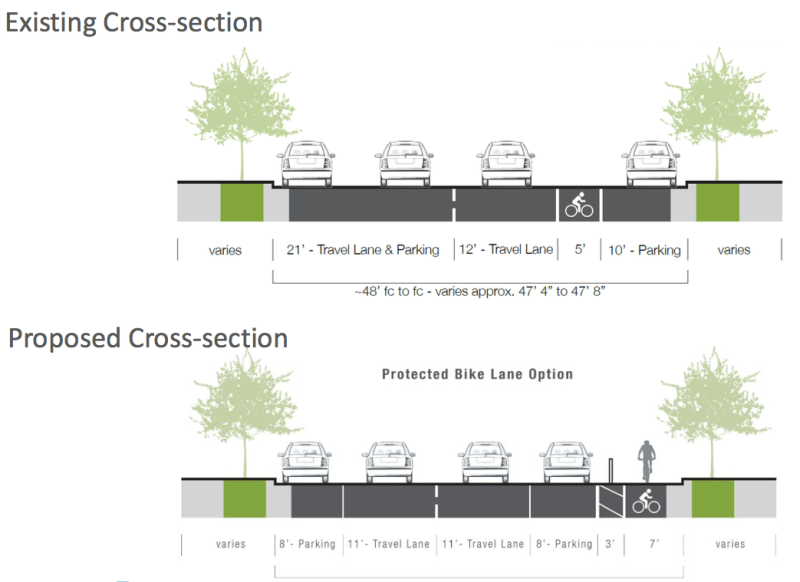Here’s a Look at the Latest Bikeway Designs for 31st Ave and MLK Blvd
Protected and buffered bike lanes will replace standard bike lanes and sharrows, but are people on bikes being prioritized or just accommodated?

At a meeting in Cole Tuesday night, Denver Public Works unveiled its latest plan to make Martin Luther King Jr. Boulevard and 31st Avenue safer for biking.
The current proposal would transform a standard striped bike lane on 31st Avenue into a parking-protected bikeway between Downing and High streets. Between High and Columbine Street, where the only semblance of bike friendliness comes in the form of a sharrow, the bike lane won’t be protected by parked cars. Instead, a 1.5-foot painted buffer will separate people on bikes from motor vehicle traffic on the speedy, one-way street.
One block north, DPW will give the same painted-buffer treatment to MLK between Elizabeth and Downing streets, replacing sharrows.
Both treatments fill gaps in the city’s bike network. Thirty-first connects to the Stout Street bikeway heading east, out of downtown, and MLK connects to the Champa Street bikeway heading west, into downtown. Both bikeways connect to the MLK bike lanes east of Elizabeth Street — which could also use some love.
DPW will reclaim some on-street parking space to make room for people on bikes, and slim down driving lanes, which should slow down drivers. Right now the driving lanes are wide, topping out at a highly unnecessary 14 feet. The road diet will bring those widths to between 10 and 11 feet, depending on the segment.

Tash Mitchell lives near MLK and York Street — an area, she says, that has been unfriendly for biking since she was a kid. She remembers wanting to bike further than a one-block radius, but her grandmother said it was too dangerous. “We just put the bikes away because she wouldn’t let us,” Mitchell said. “So safety is still an issue with the traffic, as well as some of the social kind of stuff that happens.”
Mitchell, a mother of three, thinks the redesign will make it easier for her kids to get around in a healthy, safe way. And she’s hopeful that more people on bikes will activate parts of the neighborhood that she says can be unsafe after dark.
“They need to be outside besides structured sports,” Mitchell said. “They need to love being where they live. They have bikes, but I’m not sure there’s a feeling of safety here.”
No doubt the design is an improvement over current conditions. But there’s always the question of whether the city is accommodating people on bikes — who are the more vulnerable users of these streets — or prioritizing them. For example, DPW could trade more on-street parking for a protected bikeway on MLK and the full length of 31st, or at least thin out driving and parking lanes further, so that more than 1.5 feet separates people on bikes from traffic that regularly exceeds 40 mph. The National Association of City Transportation Officials says 10 feet is plenty wide.
“Going westbound is a very scary ordeal,” said Stefanie Winzeler, 32, who lives near MLK and Elizabeth. “You’re dealing with buses pulling into stops and cars going over the speed limit and parked cars potentially opening their door on you… I have an issue with having parking next to the bike lane, although I understand that there could be residential concerns.”
This version of the bikeway is what DPW calls “60 percent design,” meaning the plan is still malleable. The streets department will hold one more public meeting in October before finalizing the design in November, and implementing it — probably in the first half of 2018.


